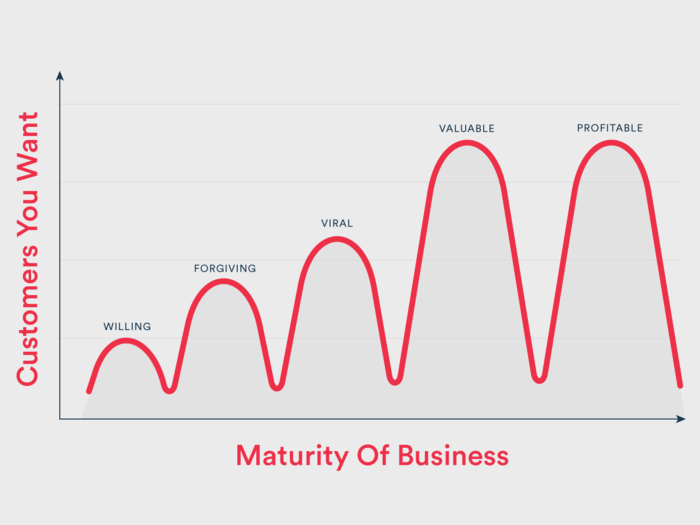- Home
- slideshows
- miscellaneous
- An early investor in Pinterest and Uber who sold a company for $100 million says there's a specific order in which young startups need to target clients
An early investor in Pinterest and Uber who sold a company for $100 million says there's a specific order in which young startups need to target clients
1. Willing explorers

2. Forgiving explorers

Your next ideal cohort of customers won't have as much patience to spend effort figuring out how your product works, but they are forgiving of its shortcomings. They'll partner with you to make it better. They are technically capable enough to withstand your cumbersome on-boarding, settings management, and other unpolished sections. Most importantly, they value a better product lacking features more than a worse product with every feature. Rather than look for a perfect fit, they're able to tolerate missing features for some period of time. To engage forgiving customers, be transparent about your roadmap. I love the way Revue, a fast-growing email newsletter tool for authors to publish newsletters, has an "open roadmap" where customers can actually see their Trello board. One way to make sure your customers are forgiving is to show them that you're aware of what is missing and working hard to improve.
3. Viral customers

Now you're ready for the customers that will spread the word (and feel the need to be early users to have the desire to spread the word). Once you have found product-market fit and will do anything to spread word of your product far and wide, you will benefit most from influential customers that are likely to tell others. These customers tend to not be forgiving, because their reputation is at stake when they spread the word. In my experience, sustained (not-hacked) virality only happens when a product is polished enough to elicit trust and love from customers that are busy. Your most viral customers are inherently busy and may not give you the benefit of the doubt. I encourage teams to engage the viral customers only when they feel ready for it (they may not give you a second chance, don't burn them).When you're confident in your product, your best customer is viral.
4. Valuable and profitable customers

These are the customers that turn you into a viable business (less handholding) and enable you to invest in the long-term durability and growth of the product. They need to be sold to and engaged in a thoughtful way, and are often pragmatists. Of course, at this point in your product lifecycle, you'll want as many customers as you can handle. As you scale and focus on revenue, you will benefit most from loyal customers that spend increasing amounts of money and time in your products. Ranking customers by LTV (lifetime value) helps Sales and Customer Service allocate resources. New product efforts are geared towards driving lifetime value, and the best customers are those with the highest LTV. You will need to add new features and consider offering better services to increase the value of customers over time. Many companies make the mistake of accommodating one type of customer at the expense of new customers. The challenge is to drive value from your loyal customers without alienating those that aren't valuable yet. At this stage, many companies take their eye off the ball when it comes to engaging and serving new customers (opening up the door for new startups to compete and win over the "less profitable" customers). Don't let this happen to you.
Seek one cohort of customers at a time

Contrary to logic, you don't want all of your customers right away. You want your first cohort of "willing" customers to be quite small, so you can communicate directly and provide an incredibly high level of touch. At the start of your business, you must do a lot of things that don't scale in order to triangulate your value proposition and build your brand. As you expand, you want to do so slowly.
So much of building a business is about patience and pace. You want to build as fast as you can, but not before you interpret the data and gain empathy for the problem you wish to solve. You want to launch as soon as you can, but not before you have a product worth the cost of PR and marketing to spread. And you want all the users or customers you can find, but not before you're able to keep them.
Popular Right Now
Popular Keywords
Advertisement